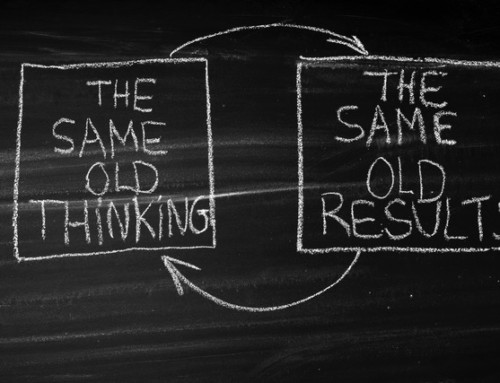Do You Speak Color’s Secret Language?
Guest Post: By Joy Overstreet, Portland’s personal color analyst
www.ColorStylePDX.com
Try this quick thought experiment: think of the color red.
What adjectives, associations or symbols come to mind when you think of red?
Did you think of passion, courage, valentines, anger, blood, energy, a politician’s tie? No doubt you came up with other associations as well.
Why does color matter to someone seeking career advancement?
Color matters because human beings respond strongly to color, though usually it’s at a subconscious level. The good news is that if you understand the psychological power of color you can communicate very particular messages in your choice of clothes.
Advertisers do this all the time when they create brand identities. The Cheerio box is happy wakeup sunshine yellow. Red Bull uses a pair of red bulls (duh) fighting. Apple Computer uses a hip cool gray apple.
Not every color looks good on everyone. Yellow would be a cheerful choice for a receptionist’s shirt, for example, but it may not be right for you. Additionally, just because many of us look good in blue, not all blues will suit your particular skin tones.
Some people look better in mostly warm colors, others in mostly cool ones. Some can pull off bright hues, while others need muted tones. Your best colors will make you look authentic and pulled together, and they will put YOU in the spotlight rather than what you’re wearing.
Three tips for choosing the right color for the right time for you.
1. Your face is always the focal point.
Unless you’re a fashion model, personal trainer or dance-hall stripper, your employers and clients are hiring your for what’s in your head and communicated by your mouth and eyes. To direct their eyes up to your face, echo your own natural coloring in what you wear on the top part of your body.
- If your jacket, shirt, tie or scarf is in your eye color, the viewer will be drawn to the repetition and gaze into your eyes. This is a great way to appear most credible when you’re trying to seal a deal.
- To appear open, friendly and approachable consider echoing the soft color of your skin tones instead of wearing the usual white shirt or blouse. Blush tones are very popular right now in the stores, as are soft beiges.
- Wearing your hair color in a sweater or accessory will also direct eyes up to your face.
2. Have a professional “do your colors”
…so you can be confident that you are choosing the most flattering colors and styles for your unique combination of skin, eyes, hair and personality. A personal color palette is a lifetime investment in easier shopping (fewer costly mistakes!), a simpler closet, and more intentional dressing. Google “personal color analyst” to find someone in your city. And personal color analysis is not just for women; most men find it immensely helpful.
3. Understand the cultural symbolism of each color
…so you can choose what to wear and what not to wear more intentionally. If you’ve had your personal color palette done, you already know which shades of red, blue, green, etc look best on you, and which you should avoid. In the color examples below, “Red” means your particular shade of red, which could be anywhere from a soft muted coral to deep crimson. And each of us has one or two colors, no matter the shade, that we should simply avoid.
Color Symbolism:
What do these three popular colors “say” about their wearer?
BLACK
Positive associations: Formal, sleek, sophisticated, mysterious, strong, striking, dramatic.
Negative associations: Mourning, somber, aloof, negative, lifeless, severe, depression, heavy
When to wear black: For bold impact and contrast with another color, as a sign of respect, in bereavement and in other cultures where the social/religious attitudes expect it, to project aloofness and keep others at a distance, for evening wear if you want to play it safe and not stand out—unless your coloring is strong AND you actually look good in black. Navy, eggplant, charcoal, deep chocolate, dark rust or forest green may be kinder, more interesting “blacks” for you.
When not to wear black: Near your face if it’s too stark for your coloring, for a TV appearance, to a wedding, to interact with children or the elderly (if you want them to open up to you), if you haven’t had time to flick off lint, dandruff or pet hair.
WHITE
Positive associations: Purity, clean, neatness, freshness, hopeful, goodness, enlightenment, spiritual, virginal, innocence, forgiveness
Negative associations: Clinical, cold, colorless, neutral. In many parts of Asia it signifies mourning.
When to wear white: For strong contrast against dark colors, for a first-time bride, to project authority or impeccable standards of hygiene for medical or high-tech (make sure it’s clean), for a dramatic look if you’ve got darker skin. If white doesn’t flatter you, pale skin tones, cream, light gray or tan and other pastels may be your better “white.”
When not to wear white: If your teeth are not very white; if it makes your skin looks sallow, or it’s too bright and “wears you;” if it’s likely you’ll get it dirty, sooty or stained.
RED
Positive associations: Stimulating, exciting, exuberant, assertive, courageous, dynamic, bright, hot, love, passion, Republican party (if you’re a member).
Negative associations: Fiery, sinful, dangerous, domineering, aggressive, threatening, loud, restless, anger, confrontational, Republican party (if you’re a Democrat)
When to wear red: To be noticed or recognized even from a distance, to attract a love interest, when you need a boost of energy, to make a brief presentation, to project authority without being threatening use just an accent of red, like in a tie or shirt/blouse with a neutral shirt or jacket.
When not to wear red: In a negotiation if you want to appear amenable, when running a meeting and you want others to participate and feel like a team, when interviewing for a job or meeting potential in-laws, if you’re making a presentation longer than ten minutes.
Color Competence: Special Offer
For my complete list of colors, their symbolism and when to use/avoid them, I’m offering a special gift to Connie Dorigan’s readers. Download the full 5-page special report at my website: www.ColorStylePDX.com/symbols.*
*To access the page: use password symbols.
Here’s to your increased success and color competence!
Joy Overstreet
Guest Post: Do You Speak Color’s Secret Language?
Connie Dorigan, Founder and Director of Recruiting, sees the food processing industry as the link between good living and good people. She’s the west coast’s most experienced and trusted food processing recruiter. She also provides Executive and Career Coaching and lots of free job search tools. Once you’ve connected with Connie, you’ll always be connected.
© 2018 Connie Dorigan. All rights reserved.
This is a general interest article and does not constitute specific or legal advice.





